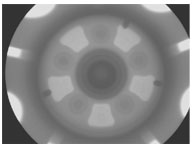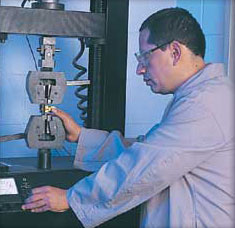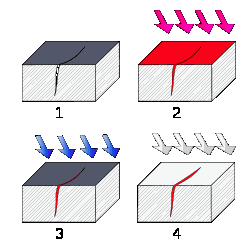Niagara Investment Castings produces commercial quality level castings, as well as upgraded castings for more stringent applications. We can provide all levels of testing and inspection to verify quality and certify our investment castings to meet your strict requirements. From a simple but thorough visual examination, to today’s latest Non-Destructive testing methods, Niagara Investment Castings provides a full range of material testing and related certifications.
______________________________________________________________________________________________________________________________________________
Chemical analysis is the cornerstone of foundry metallurgy, and therefore Niagara Investment Castings utilizes state-of-the-art spectroscopy to analyze both ferrous and non-ferrous alloys for chemical content for EVERY heat of metal produced. Certified universal standards are used to verify every analysis. In instances where chemical analysis requirements are even greater, sample preparation (by milling or drilling) and a full range of “wet analysis” testing is performed according to the strictest specifications at our accredited 3rd party laboratory.
Our metallurgical services include cross-sectioning, mounting & polishing specimens for microscopic examination including grain structure, grain size, inclusion rating, depth of carburization, case depth and more.
Tension Testing is carried out to test the tensile properties of the metals we produce. The most common standards that we test to are as follows:
- Elevated Temperature Tension Tests ASTM E21
- Standard Tension Testing per ASTM E8, ASTM A370, and ASTM B557
- Strain Hardening Exponent (n Value) ASTM E646 and Plastic Strain Ratio (r Value) ASTM E517
- Stress Rupture Test (to 2000°F) machine -ASTM E139 and ASTM E292
Impact Testing
- Charpy V-notch Impact Testing per ASTM E23
- Rectangular or Round Izod Testing per ASTM E23, BAEP 9004
Hardness Testing
- Brinell Hardness per ASTM E10
- Rockwell Hardness per ASTM E18
 Radiographic Testing (RT), is a non-destructive method of inspecting materials for hidden flaws by using the ability of short wavelength electromagnetic radiation (high energy photons) to penetrate various materials. Either an X-ray machine or a radioactive source can be used as a source of photons.
Radiographic Testing (RT), is a non-destructive method of inspecting materials for hidden flaws by using the ability of short wavelength electromagnetic radiation (high energy photons) to penetrate various materials. Either an X-ray machine or a radioactive source can be used as a source of photons.
The major objective of radiographic testing of castings is the disclosure of defects that adversely affect the strength of the product. Castings are a product form that often receive radiographic inspection since many of the defects produced by the casting process are volumetric in nature, and are thus relatively easy to detect with this method. These discontinuities are related to casting process deficiencies, which enable us to address suitable corrective measures. Since different types and sizes of defects have different effects of the performance of the casting, it is important that the customer knows what level of acceptance he requires to enable us to identify the type and size of the defects and how they may or may not affect the end use of the casting. Niagara Investment Castings is capable of manufacturing our castings to virtually any radiographic level of quality.
Dye penetrant inspection (DPI), also called liquid penetrant inspection (LPI), is a widely applied and low-cost inspection method used to locate surface-breaking defects in all investment castings. LPI is used to detect casting defects, cracks, and leaks in new products, and can be also used to locate fatigue cracks on in-service components.
- Section of material with a surface-breaking crack that is not visible to the naked eye.
- Penetrant is applied to the surface.
- Excess penetrant is removed.
- Developer is applied, rendering the crack visible.
In addition to our most common material tests and certification capabilities, we are pleased to also offer :
Hydrogen Embrittlement Relief Testing
Lever arm testers are used in the testing of plated castings and test specimens to verify that hydrogen embrittlement has not occurred during any plating processes.
Notched Bar Impact Testing
Impact tests on notched specimens are used to predict the likelihood of brittle fracture at a specified temperature.
Microscopic Examination Testing includes :
- Microstructure per ASTM E3
- Grain Size including McQuaid Ehn method per ASTM E112
- Microcleanliness / Inclusion Rating per ASTM E45 Methods
- Volume Percent Determination per ASTM E1245
- Plating Thickness per ASTM E3
- Microhardness Testing (Vickers or Knoop 50g to 1000g) per ASTM E384
Macroscopic Examination Testing includes:
- Particle Count for cleanliness
- Weld Evaluation per ASME IX, CSA W47.1, AWS D1.1, and EN 1321
- Visual Evaluation and photos
- Vickers Hardness Testing HV1-HV50 per ASTM E92


